Open MFA is a club for artists. On their website, they describe themselves as “We are a resource for artists to continue their education, whether they already have a university degree, intend to pursue one in the future, or want to pursue an alternative route.” So in a way, they have an educational purpose. But from what I can see, it feels more like a voluntary gathering of pretty much any artist who wants to join. Obviously there are historic precedents—artists in the same geographic area joining forces. Some have an idea or organizing principle—think of the surrealists or the Dadaists in Paris and Zurich respectively. Some get together in a particular space—think of the artists at the Bateau-Lavoir, inventing both cubism and modernist poetry, or the many studios that popped up in Houston in the past few decades (Commerce Street Artists Warehouse, Box 13, etc.) Like all those places and groups, Open MFA offers artistic fellowship, but also occasional exhibition opportunities.
At Flatland Gallery, Open MFA has a show up called Gathering What’s Tangible, curated by Erica Reed Lee. This is explicitly a “post-Covid” group show (I put “post-Covid” in quotes because people still die of Covid every day, after all). Just prior to lockdown, the group had been planning to do a group exhibit of collaborative works. Covid put paid to that. For over a year, these artists were huddled in their homes, figuring out what to do. How they occupied themselves during this period is the content of this exhibit.
Lee noticed that a lot of the artists in Open MFA adopted labor-intensive crafts to pass their time in isolation. In addition to the value of keeping oneself busy during a period of enforced idleness, the benefit, Lee theorizes, is that craft permits one to have a tangible project as opposed to a electronically mediated life. Craft is the opposite of a Zoom call.
I want to start with the pieces by Jen Bootwala. She was a design student at the University of Houston, as one might deduce from her piece “School Spirit: University of Houston.” Aside from the UH school colors, I’m not sure what the images in this diptych are meant to represent. They look like symbolic objects used in mapping or technical design. The symbols are red against a white background. It appears to be knitted (or perhaps crocheted—I get them confused). It does not have the letters “U.H.” or an image of a cougar. The school spirit seems to be purely in the colors, although maybe the symbols have a relation to the school that UH students might recognize, but that I don’t.
“Time, like yarn” goes right to the idea of the show. Bootwala knit many sweaters during quarantine. This piece is an installation that consists of 27 sweaters (presumably all made by Bootwala) and two knit calendars. The calendars are knit rectangles with spaces for 12 months on them. One is for 2020, the other for 2021. It seems to say, Covid not only didn’t keep me from doing, it encouraged me to do more.
Alexandra Isabel Lechin’s work is also labor intensive and touches on craft, but I think the labor-intensive aspect of her work precedes Covid. On her Instagram page, she identifies herself as ” Moiré Maven”. Here work is about patterns made from intersecting lines and shapes. She Venezuelan-American and has said, “My work has been predominantly influenced by Venezuelan artists such as Carlos Cruz-Diez, Jesus Soto, and Gego.” (Fortunately, one can see ample selections of the work of all three of these Venezuelan maestros at the MFAH.) She has three pieces in the show, “The Skin We Wear”, “Miner con las Patas Cruzadas/Woman With Crossed Feet” and a collaboration with Erica Reed Lee called “Separately Together.” The last of these was presumably conceived back when the next Open MFA exhibit was intended to be all collaborative pieces.
“Separately Together” is geometric, but hand-made. It seems like the kind of piece that could have been created on a Jacquard loom, but every bit of it was sewn and embroidered by hand. I think perhaps the hand-stitching is what links it to the theme of the exhibit.
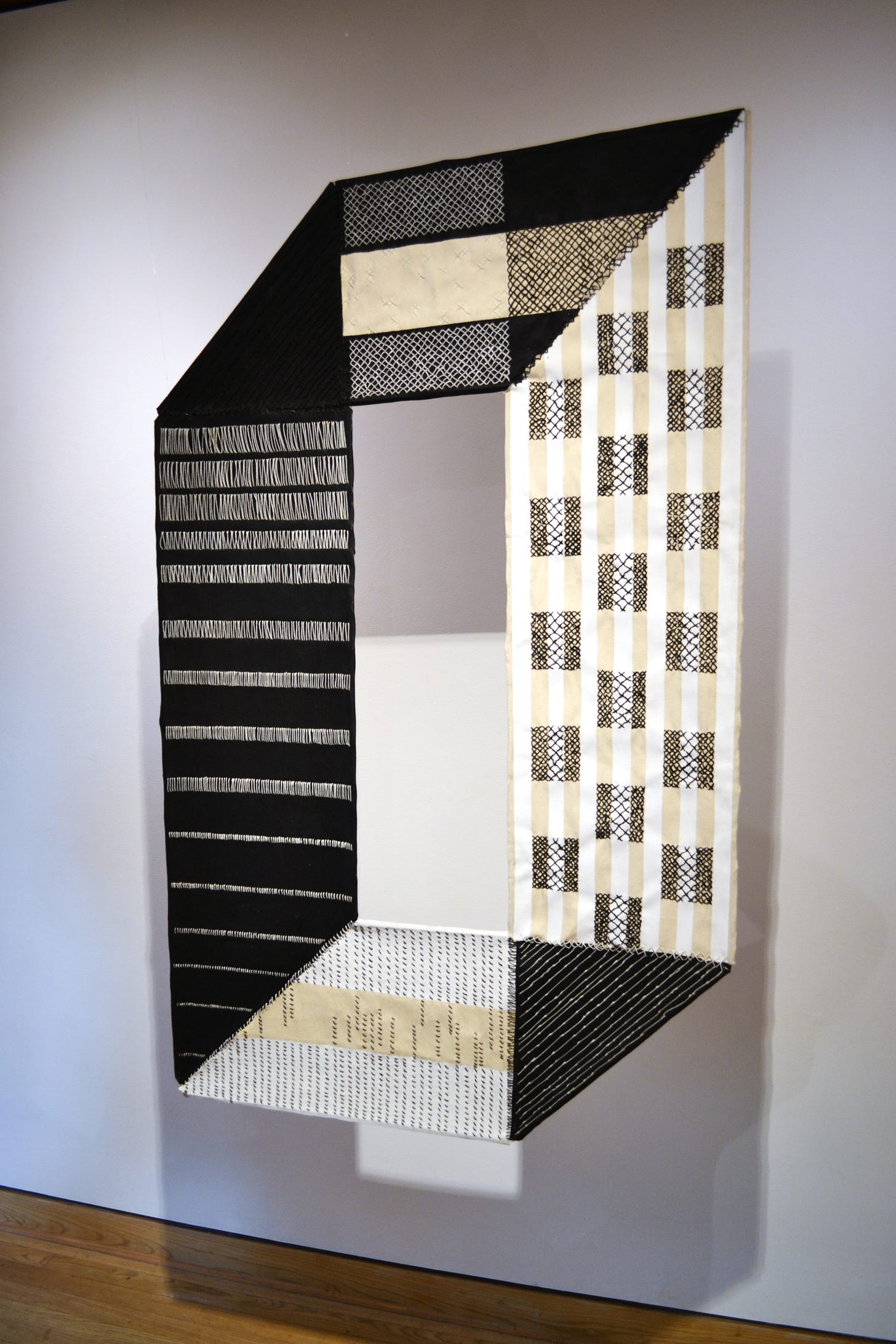
“The Skin We Wear” is an irregularly-shaped black ceramic vessel with tiny white dots covering it. I don’t know how she put the white dots on it, but it looks labor intensive: each one is carefully painted but not identical to the others. Nor are they lined up in a perfectly geometrical way.
“Miner con las Patas Cruzadas/Woman With Crossed Feet” is a large black-and-white painting that, according to Lechin, contains the image of a cross-kegged woman that is obscured by bands of white and lots of tiny black marks. To be honest, I couldn’t see the woman in the image—Lechin has abstracted the figure so much that it mostly disappears into the abstract swirl of marks.

Lorena Mitchell is a digital artist and animator—which seems about as far from “craft” as one can get, but the level of precision and labor that animation requires is surely equal to labor-intensive crafts. But for the triptych she created employing punch needle embroidery, she has gone back to a fairly ancient craft technique in her piece called “The Lonely Cherubs: Apathy, Boredom and Relief.”

One might think these cherubs look familiar. Mitchell is quoting a Renaissance classic, Raphael’s Sistine Madonna, painted around 1513. Two of Mitchell’s three cherubs are based on the cherubs in this painting. They have been a much-loved image of lovable babies for over 500 years.
Helen Sharpless collects old fabrics. Her task during Covid, as I understand it, was to organize them by color. Her pieces in this show are collages made of these swatches of fabric. Collage might be the wrong word: the pieces appear sewn, not glued. In a way, they feel like they are halfway between collage and quilt. This one is called “Altered Remnants”.
Sharpless is not the only artist in the show using fabric remnants. Dana Caldera also employs bits of fabric. Caldera’s work is described as collage, so she seems to be gluing fabric pieces together. Her pieces are hung on a length of rope. It reminds me of laundry on a clothesline.
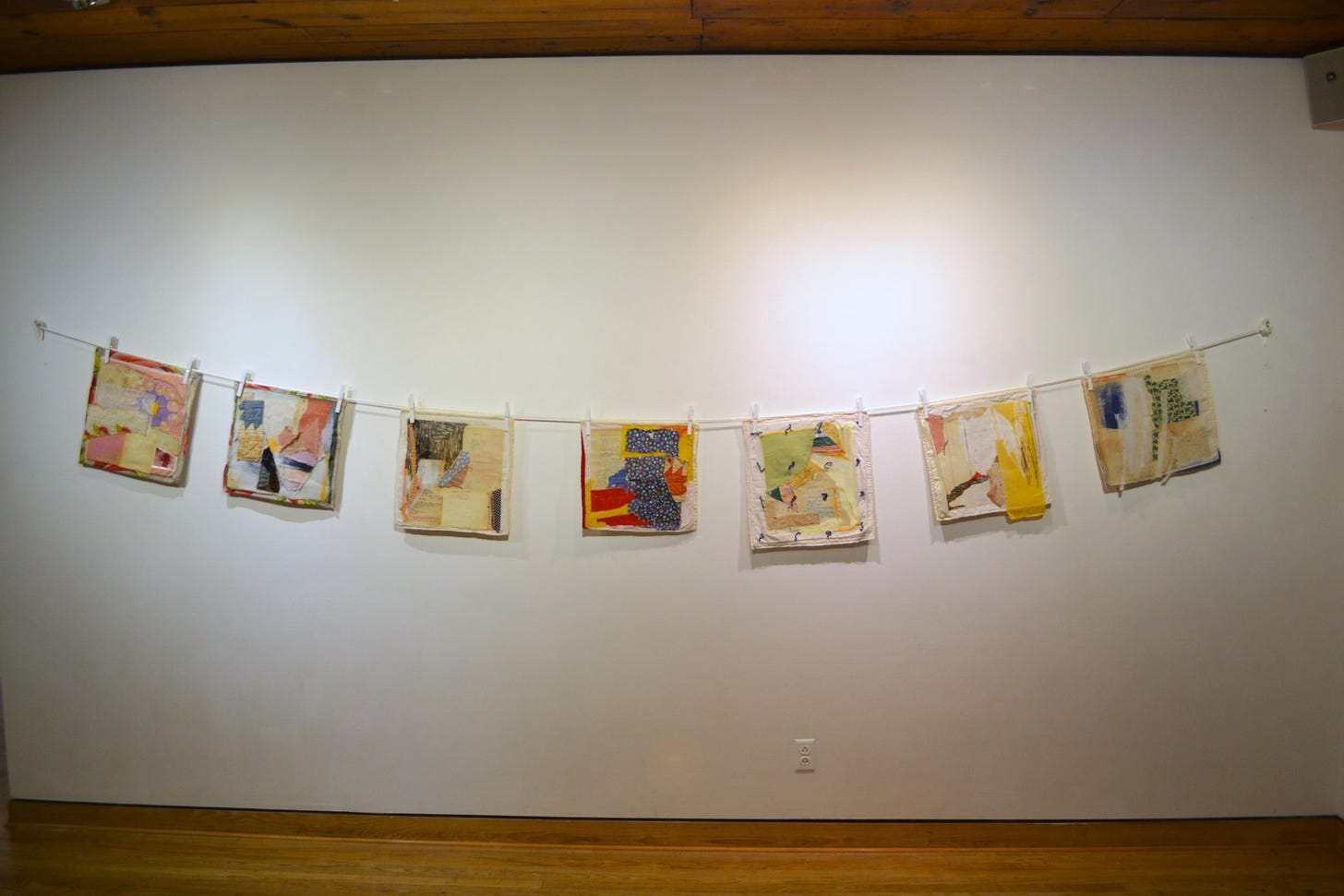
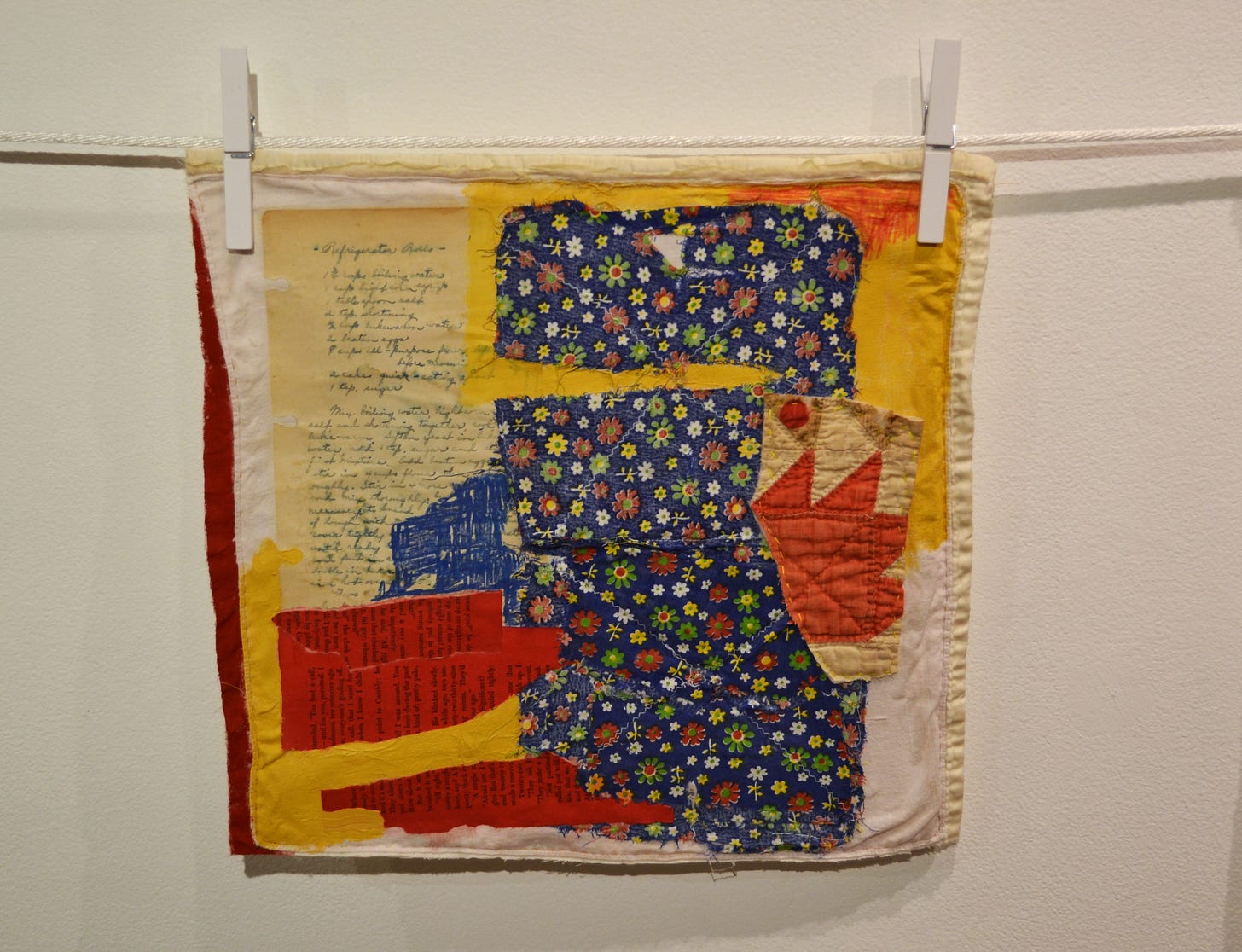
The work of Sharpless and Caldera has a superficial resemblance to recent work by Gabriel Martinez, about which I’ve written about before. The main difference is that Martinez takes his found fabric (literally found on the street), and actually quilts it.
These are just a few of the pieces in the show. I also like work by Amanda Powers, Hugo Perez, and Cynthia Giron.
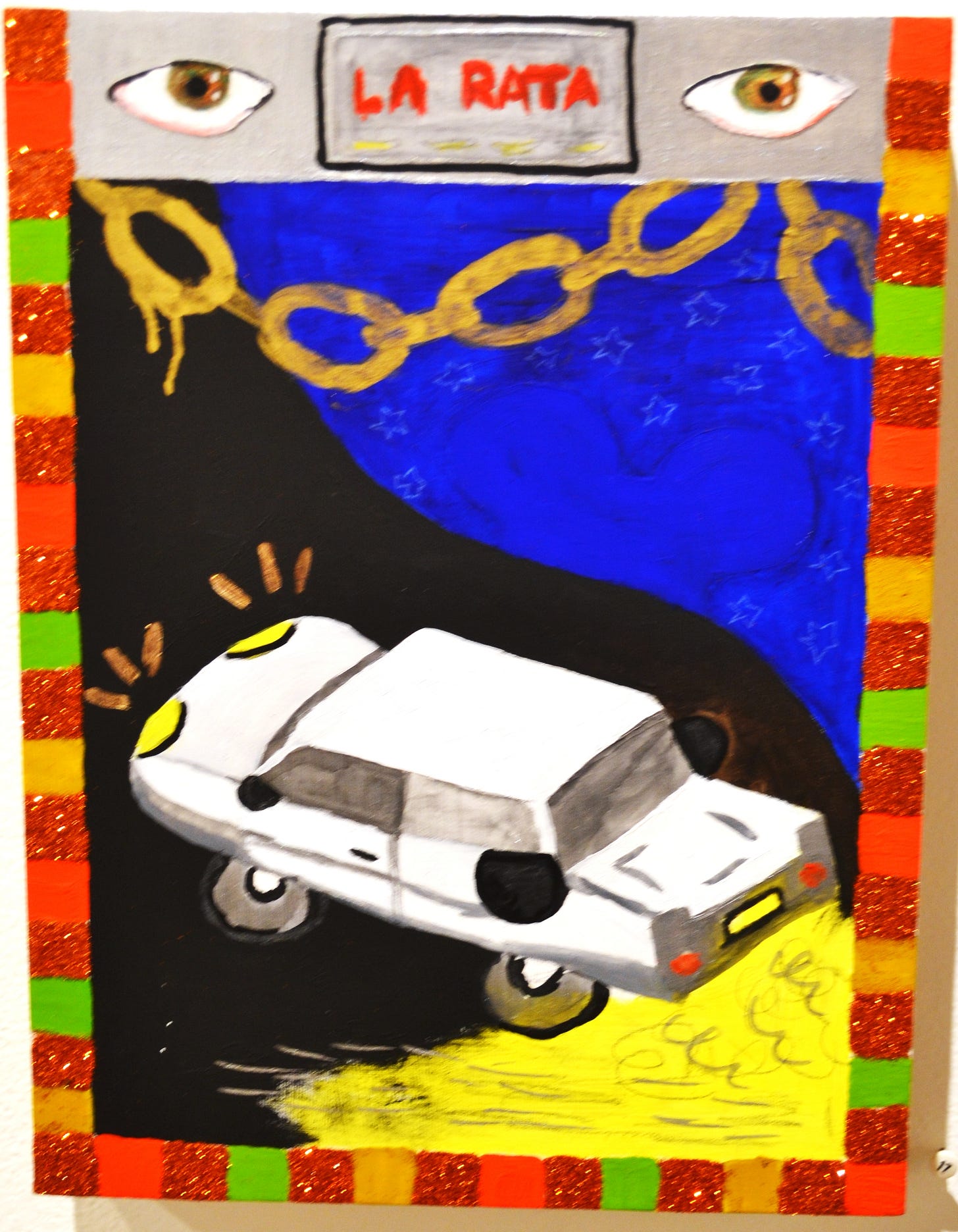
If you haven’t seen this exhibit, you had better hurry. It runs through May 22.
[Please consider supporting my work by becoming a patron, and you can also support my work by patronizing my online store. And one more way to support what I do here is to buy books through my bookstore. ]







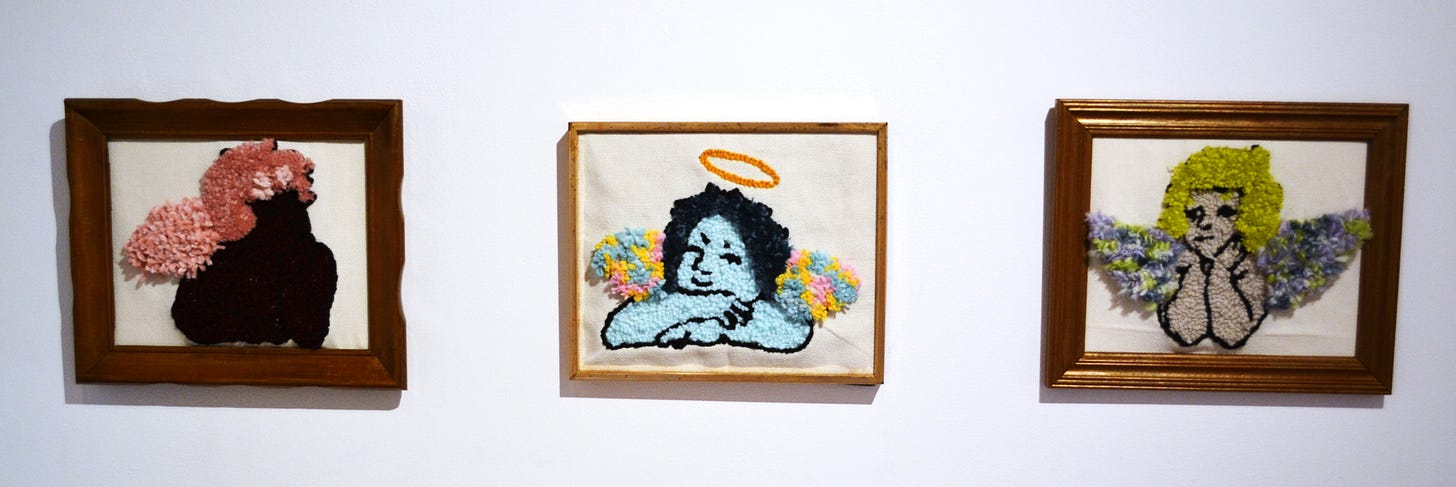




Great summary, it was great to meet you. Keep on blogging. Here is a great carbon article you might find interesting. https://e360.yale.edu/features/soil_as_carbon_storehouse_new_weapon_in_climate_fight